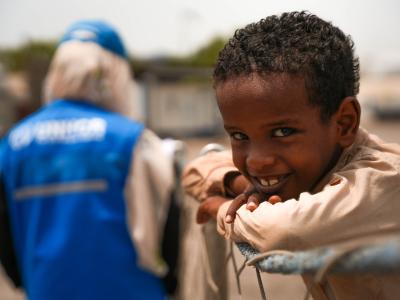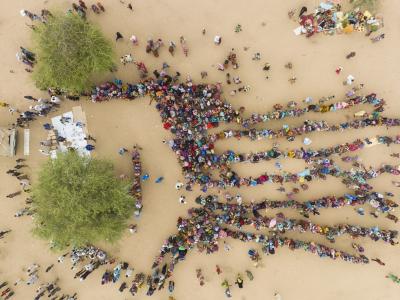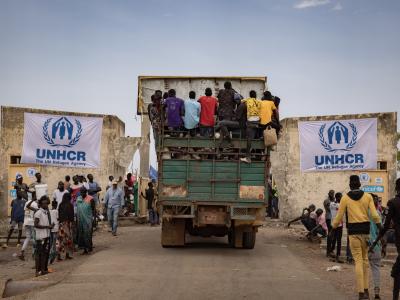Forced displacement and statelessness make people vulnerable. Their vulnerability is exacerbated if they cannot participate in decisions concerning their own lives and they cannot work, study or travel. Women and girls are almost invariably at even greater disadvantage. UNHCR advocates for their full enjoyment of rights, but countries with fragile economies sometimes struggle to integrate large influxes of refugees, and in some countries xenophobic voices may drown out the arguments for welcoming them with kindness and goodwill. A global survey of attitudes towards refugees, with 20,000 respondents in 29 countries, found 74% of people supported the principle of giving people refuge and 33% had taken personal action in support of refugees in the previous 12 months. But the survey, published to mark World Refugee Day in June 2023, also found that support had dampened since 2022. People were divided on whether their country should accept more refugees, and the majority were concerned that refugees were not genuine.
In 2023, 39 UNHCR country operations reported on the extent of refugees’ and asylum-seekers’ participation in the UNHCR programming cycle, as UNHCR worked to ensure people were included in the decisions that affect their lives. Out of 39 countries, 25 reported “extensive” participation, 11 said it was “moderate”. Globally, an estimated 74% of refugees (in the 57 countries reporting data) and 73% of IDPs (in 20 countries) had access to safe feedback and response mechanisms.
The risks and dangers faced by people who have been forced to flee make basic safety a pressing need, in ways that may be taken for granted by less vulnerable populations. As one simple but important measure, UNHCR collects data on the numbers who feel safe walking alone in their neighbourhood after dark. In 2023, 62 out of 77 countries where UNHCR reported on this indicator said more than 50% of refugee and asylum-seekers reported feeling safe. That result was similar to 2022 for refugees and asylum-seekers, but the data suggested a worsening of the situation for IDPs. A majority of IDPs felt safe in only 10 of the 18 countries reporting in 2023, compared to 14 out of 18 countries in 2022. There was also a lower indicator for stateless people, with 60% feeling safe, down from 94% in 2022, with 17 countries reporting data, up from eight in 2022.
Providing refugee children with education is vital to ensure they can realize their potential, and they tend to do particularly well in school, on average. In 2023, an estimated 72% of refugee and asylum-seeking children were enrolled in primary education, according to data reported by 90 UNHCR country operations, up from 70% in 2022. Seven countries had fewer than 25% of children enrolled, down from 10 countries in 2022.
However, for secondary education the estimated enrolment rate fell to 45%, from 49% in 2022, and the number of countries reporting enrolment of less than 25% rose to 28, from 25 previously. In most of the 87 countries where UNHCR collected secondary school enrolment data in 2023, the majority of refugee and asylum-seeking children were not enrolled.
It is estimated that just 7% of refugee youth worldwide were accessing higher education as of 2023, compared to a global average of 42%. This figure has, nevertheless, advanced significantly since 2019, when it stood at 1%, and UNHCR has set a target of 15% refugee enrolment in tertiary education by 2030.
Financial inclusion of refugees also increased. In 2023, a majority of refugees lived in countries where financial institutions recognized identity documents issued by the government or by UNHCR to open an account. 44% of asylum-seekers and refugees had an account with a bank or other financial institution, or with a mobile money service provider, based on reporting from 54 countries in 2023. That compares to 30% in 2022, based on data from 51 countries. For IDPs, the percentage decreased from 41% to 34%, based on reports from 12 countries in 2023 and 9 in 2022. However, data from UNHCR operations showed that very few forcibly displaced people saw a positive change in their income during the year.
Financial overview
Budget and expenditure
-
UNHCR’s 2023 budget for this Impact Area was $1.385 billion or 13.2% of programmed activities.
-
Expenditure of $588.5 million accounted for 11.4% of total expenditure. This represents a decrease of $210.3 million or 26.3% when compared to $798.8million in 2022
-
The largest budgets were for Pakistan, South Sudan, Türkiye and the Syrian Arab Republic.
Global expenditure and budget for Impact Area "Empower"
$588.5 million spent against a budget of $1.385 billion
$797 million of unmet needs or 58% of the budget




